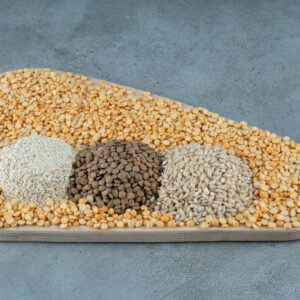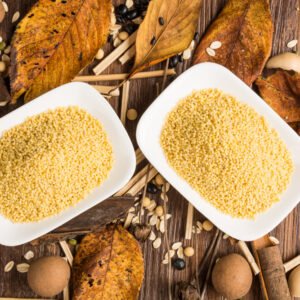When it comes to choosing the right grains for your daily diet, the debate between broken raw rice and high fiber grains has gained significant attention among health-conscious consumers. With the global agricultural market offering diverse grain options, understanding the nutritional profiles and health implications of these choices becomes crucial for making informed dietary decisions.
Both broken raw rice and high fiber grains like quinoa, barley, and oats serve as staple foods worldwide, but their impact on your health varies dramatically. This comprehensive comparison will help you determine which option aligns better with your nutritional needs and health goals.
Understanding Broken Raw Rice: Nutritional Profile and Benefits
Broken raw rice, often considered a byproduct of rice processing, has emerged as a viable nutritional option in many cultures. Unlike whole grain rice, broken rice consists of fragmented kernels that occur during milling, yet it retains many of the original grain’s nutritional properties.
Key Nutritional Components
Broken raw rice provides essential carbohydrates that serve as the body’s primary energy source. A typical serving contains approximately 150 calories per cooked cup, with about 35 grams of carbohydrates. While it contains minimal fiber compared to whole grains, broken rice offers easily digestible energy that can be beneficial for individuals with sensitive digestive systems.
The grain contains moderate amounts of protein, typically around 3-4 grams per serving, along with small quantities of B vitamins, particularly thiamine and niacin. These vitamins play crucial roles in energy metabolism and nervous system function.
Health Benefits of Broken Raw Rice
One significant advantage of broken raw rice is its gentle impact on the digestive system. The smaller grain fragments require less digestive effort, making it suitable for individuals recovering from illness or those with gastrointestinal sensitivities. The easily digestible nature of broken rice can help regulate gut health and support bowel movements.
Broken raw rice also provides quick energy release, making it beneficial for athletes or individuals requiring immediate energy replenishment. Its low fat content and gluten-free nature make it suitable for various dietary restrictions and weight management plans.
High Fiber Grains: Nutritional Powerhouses
High fiber grains represent a category of whole grains that have retained their bran and germ layers, resulting in significantly higher fiber content and enhanced nutritional profiles. Popular options include quinoa, barley, oats, brown rice, and ancient grains like farro.
Exceptional Fiber Content
The defining characteristic of high fiber grains is their substantial fiber content, typically ranging from 6-15 grams per serving. Barley leads this category with approximately 14 grams of fiber per cooked cup, followed by quinoa with 5 grams and oats with 4 grams per serving.
This fiber content includes both soluble and insoluble varieties. Soluble fiber helps regulate blood sugar levels and cholesterol, while insoluble fiber promotes healthy digestion and regular bowel movements.
Complete Nutritional Profiles
High fiber grains offer superior protein quality compared to broken raw rice. Quinoa stands out as a complete protein source, containing all nine essential amino acids. A cup of cooked quinoa provides 8 grams of high-quality protein, significantly higher than broken rice.
These grains also excel in micronutrient content. Barley provides excellent sources of selenium, manganese, and phosphorus. Quinoa offers substantial amounts of magnesium, iron, and folate. Oats contain beta-glucan, a specific type of soluble fiber linked to heart health benefits.
Broken Raw Rice vs High Fiber Grains: Health Impact Comparison
Digestive Health and Gut Function
When comparing digestive impacts, broken raw rice offers easier digestion due to its processed nature and smaller particle size. This makes it suitable for individuals with digestive disorders or those transitioning back to solid foods after illness.
High fiber grains provide superior long-term digestive benefits through their fiber content. The combination of soluble and insoluble fiber promotes healthy gut bacteria, regular bowel movements, and improved overall digestive function. However, individuals unaccustomed to high fiber intake may experience initial digestive discomfort.
Blood Sugar Management
Broken raw rice has a higher glycemic index, causing more rapid blood sugar spikes. This quick energy release can be beneficial for immediate energy needs but may not be ideal for individuals managing diabetes or seeking steady energy levels throughout the day.
High fiber grains excel in blood sugar regulation due to their fiber content and complex carbohydrate structure. The fiber slows glucose absorption, preventing rapid blood sugar spikes and promoting sustained energy release. This makes them superior choices for diabetes management and long-term metabolic health.
Weight Management Considerations
For weight management, broken raw rice provides fewer calories per nutrient compared to high fiber grains. While it offers quick energy, it lacks the satiety-promoting properties of fiber-rich alternatives.
High fiber grains support weight management through increased satiety and prolonged fullness. The fiber content requires more energy to digest, potentially boosting metabolism, while the protein content helps maintain muscle mass during weight loss efforts.
Cardiovascular Health Benefits
Broken raw rice offers minimal cardiovascular benefits beyond being naturally low in saturated fat and cholesterol-free. Its refined nature reduces many of the heart-healthy compounds found in whole grains.
High fiber grains provide substantial cardiovascular benefits. The soluble fiber, particularly beta-glucan found in oats and barley, helps reduce LDL (bad) cholesterol levels. The antioxidants, minerals, and healthy fats present in these grains contribute to improved heart health and reduced cardiovascular disease risk.
Making the Right Choice for Your Health Goals
When Broken Raw Rice Makes Sense
Choose broken raw rice when you need easily digestible energy, have digestive sensitivities, or require quick energy replenishment. It’s also suitable for individuals following specific cultural dietary patterns or those who prefer milder grain flavors.
For athletes requiring immediate energy or individuals with inflammatory bowel conditions, broken raw rice can provide necessary calories without digestive stress.
When High Fiber Grains Are Superior
High fiber grains are the better choice for long-term health optimization, weight management, blood sugar control, and cardiovascular health. If you’re looking to increase nutrient density in your diet, these grains provide significantly more vitamins, minerals, and beneficial plant compounds.
For individuals focused on diabetes prevention, heart health, or sustainable weight management, incorporating high fiber grains like quinoa, barley, and oats provides superior health benefits.
Quality Matters: Sourcing Premium Grains
The health benefits of any grain depend significantly on its quality and sourcing. Premium agricultural products ensure optimal nutritional content and minimal contamination. Companies like CMS Industries, a leading agricultural products manufacturer and supplier in India, focus on providing high-quality grains, pulses, and other agricultural commodities that meet international standards.
When selecting grains for your diet, consider sourcing from reputable suppliers who prioritize sustainable farming practices and quality assurance. This ensures you receive maximum nutritional benefits from your chosen grains.
Practical Integration Strategies
Incorporating Broken Raw Rice
Use broken raw rice in porridges, congee, or as a quick-cooking side dish. Its shorter cooking time makes it convenient for busy schedules, while its mild flavor pairs well with various cuisines.
Maximizing High Fiber Grain Benefits
Gradually introduce high fiber grains to prevent digestive discomfort. Start with smaller portions and increase slowly as your digestive system adapts. Combine different high fiber grains throughout the week to maximize nutritional variety.
Prepare these grains in bulk and store them for convenient meal preparation. Their robust flavors and textures make them excellent bases for grain bowls, salads, and hearty soups.
The Verdict: Context Determines the Winner
The choice between broken raw rice and high fiber grains ultimately depends on your individual health needs, digestive tolerance, and long-term wellness goals. While broken raw rice serves specific purposes, particularly for digestive sensitivity and quick energy needs, high fiber grains provide superior overall nutritional benefits for most healthy individuals.
For optimal health, consider incorporating both options strategically. Use broken raw rice when your digestive system needs gentleness or when quick energy is required, and rely on high fiber grains as your primary grain choice for daily nutrition and long-term health benefits.
The key lies in understanding your body’s needs, consulting with healthcare professionals when necessary, and making informed choices based on quality ingredients from trusted agricultural suppliers.
Frequently Asked Questions
Q1: Is broken raw rice easier to digest than high fiber grains?
Yes, broken raw rice is generally easier to digest due to its smaller particle size and lower fiber content, making it suitable for sensitive digestive systems.
Q2: Which option is better for blood sugar control?
High fiber grains are superior for blood sugar control due to their fiber content, which slows glucose absorption and prevents rapid spikes.
Q3: Can broken raw rice support weight loss?
While broken raw rice is lower in calories, high fiber grains provide better satiety and sustained energy, making them more effective for weight management.
Q4: Are high fiber grains suitable for everyone?
Most people benefit from high fiber grains, but individuals should gradually increase intake and consult healthcare providers if they have digestive conditions.
Q5: How do I choose quality grains for maximum health benefits?
Select grains from reputable agricultural suppliers who prioritize quality assurance and sustainable farming practices to ensure optimal nutritional content and safety.





